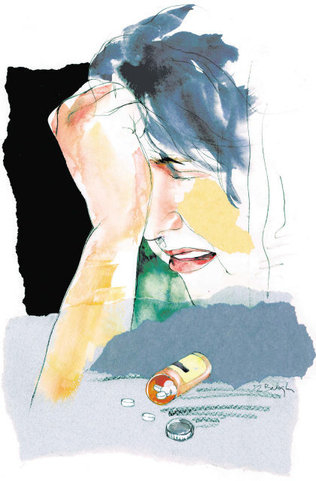|
|
Substance Abuse in Seniors
Expected to Rise
By Rebecca Burton, Miami Herald
April 16, 2012

Image Credit: Dennis Balogh,
MCT
For a 63-year-old Miami
school librarian who had never taken a sip of alcohol,
the threat of addiction never crossed her mind.
Thinking her prescription for Xanax, a popular drug in
treating anxiety, was as safe as her blood pressure
medicine, she and her family didn’t see the warning
signs of addiction until the weekend Maria slept for
five days straight. That’s when her daughter, son and
husband admitted her to South Miami Hospital’s
Addiction Treatment Center, where she was detoxified.
While addiction often is associated with young people,
Maria’s situation is not at all uncommon.
According to a recent report by the Substance Abuse
and Mental Health Services Administration, the number
of U.S. adults age 50 or older needing substance abuse
treatment is expected to double from 2.8 million to
5.7 million by the year 2020. A 2010 report by the
Drug Abuse Warning Network said drugs used for pain
relief, anxiety or insomnia were involved in almost a
quarter of adverse drug reactions among older adults.
“Oxycontin is the number one problematic drug right
now. But also, older people tend to deal with more
feelings of loneliness and sadness and are prescribed
anxiety and anti-depressants that can be abused as
well,” said Chip Hobbs, residential services manager
at South Miami Hospital’s Addiction Treatment Center.
For about 80 percent of the population,
prescribing these drugs is the right thing to do, he
said. For about 20 to 25 percent, however, there is a
risk of developing a dependency.
Painkillers “are supposed to be prescribed in
combination with physical therapy in order to heal the
injury,” Hobbs said.
“But what happens is that the drug itself can
promote pain. All of a sudden, the drug has a life of
its own and it starts to create pain in the patient.
They then go back to the doctor and, if the doctor has
not been trained in addiction medicine, they, of
course, have to treat pain. That’s when they get
locked up with a patient that all of a sudden loses
their prescription or something happens to it. The
patient starts calling in earlier and earlier than
normal for a refill and that’s sort of a flag now.”
Maria started taking Xanax when she was about 40.
“I had a lot of problems with a child I adopted
because he was an addict, and ended up having a
nervous breakdown,” Maria said. “My doctor in Puerto
Rico prescribed me Xanax, with a dosage of 2mg.”
“Xanax is an interesting drug,” Hobbs said. “Say you
take 1mg a day, tomorrow morning half a milligram will
still be in your system. Eventually the drug starts
accumulating and the body gains tolerance.”
Maria said she would cut the pill into smaller pieces
and take a little bit when she woke up, in the
afternoon. She would take a whole pill when she went
to bed at night.
“The pill made me very sleepy,” she said. “All I would
want to do is sleep in order to forget about
everything. I didn’t know what I was doing was bad.”
Eventually, Maria decided to cut back on her own
but realized the side effects were unbearable.
“When I stopped taking it, I was nervous, shaking a
lot, sweating and it was more or less like a panic
attack,” Maria said. “But eventually, I started to get
better.”
“Most times, medical supervision is needed to be
weaned off of these drugs because there can be risks
as serious as seizures caused from withdrawals,” Hobbs
said.
It wasn’t until Maria moved to Miami 10 years ago to
live close to her children and grandchildren that she
started taking Xanax again.
“When I came to Miami, things were very hard for us. I
didn’t have any friends, I had my children but they
had their own things going on, so I started feeling
very lonely,” Maria said. “All I had to do to get the
drug again was tell my primary care doctor that I
received it in Puerto Rico and he just prescribed it
to me.”
Maria also began going to multiple doctors to get the
prescription. Hobbs refers to this as “doctor
shopping,” a common pattern in prescription drug
abuse.
Since Presidents’ Day weekend was a long weekend, she
took more Xanax than she would during the week.
“I had a brand new bottle, so I started taking it and
then everything was a blur,” she said. “The thing is
with Xanax, you forget. I couldn’t remember if I had
taken it or not so I just kept taking it.”
Maria slept from Friday to Monday without eating, and
called in sick to work on Tuesday and Wednesday
because she could not get out of bed. Maria is still
working at the same place today, but plans to retire
next year.
“Finally on Wednesday I had the strength to get up and
get a glass of water. When I went down around 2 p.m.,
my entire family was there at a time they should’ve
been at work,” Maria said. “They told me, ‘That’s it,
we’re going to a hospital.’ ”
Maria was medically detoxified at South Miami Hospital
and enrolled in an outpatient program where she
attends daily group therapy sessions.
“Group therapy especially helps with the stigma and
shame that comes along with addiction. It helps to sit
with people who understand you on a cellular basis,”
Hobbs said.
Hobbs recommends that patients seeking pain pills or
anxiety drugs ask their doctor for an evaluation to
determine their risk for dependency. “The recipe for
disaster is an innocent patient with an ignorant
doctor. Not enough doctors are trained on addiction,”
Hobbs said.
More Information on US Health
Issues
|
|



